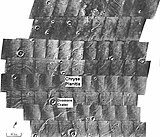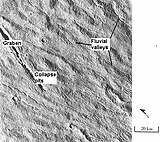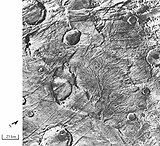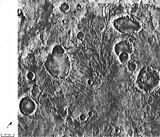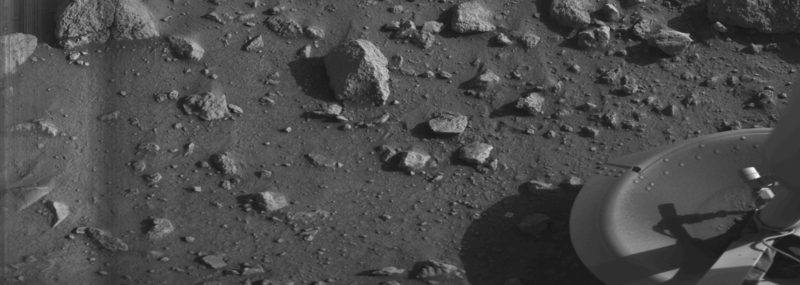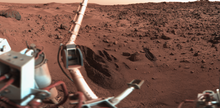Viking program
JPL | |
| Applications | Mars orbiter/lander |
|---|---|
| Specifications | |
| Launch mass | 3,527 kilograms (7,776 lb) |
| Power | Orbiters: 620 watts ( solar array) Lander: 70 watts (two RTG units) |
| Regime | Areocentric |
| Design life | Orbiters: 4 years at Mars Landers: 4–6 years at Mars |
| Production | |
| Status | Retired |
| Built | 2 |
| Launched | 2 |
| Retired | Viking 1 orbiter August 17, 1980[1] Viking 1 lander July 20, 1976[1] (landing) to November 13, 1982[1] Viking 2 orbiter July 25, 1978[1] Viking 2 lander September 3, 1976[1] (landing) to April 11, 1980[1] |
| Maiden launch | Viking 1 August 20, 1975[1][2] |
| Last launch | Viking 2 September 9, 1975[1][3] |
The Viking program consisted of a pair of identical American
designed to study the planet from the surface. The orbiters also served as communication relays for the landers once they touched down.The Viking program grew from NASA's earlier, even more ambitious, Voyager Mars program, which was not related to the successful Voyager deep space probes of the late 1970s. Viking 1 was launched on August 20, 1975, and the second craft, Viking 2, was launched on September 9, 1975, both riding atop Titan IIIE rockets with Centaur upper stages. Viking 1 entered Mars orbit on June 19, 1976, with Viking 2 following on August 7.
After orbiting Mars for more than a month and returning images used for landing site selection, the orbiters and landers detached; the landers then entered the Martian
The project cost was roughly US$1 billion at the time of launch,[5][6] equivalent to about $6 billion in 2023 dollars.[7] The mission was considered successful and is credited with helping to form most of the body of knowledge about Mars through the late 1990s and early 2000s.[8][9]
Science objectives
- Obtain high-resolution images of the Martian surface
- Characterize the structure and composition of the atmosphere and surface
- Search for evidence of life on Mars
Viking orbiters
The primary objectives of the two Viking orbiters were to transport the landers to Mars, perform reconnaissance to locate and certify landing sites, act as communications relays for the landers, and to perform their own scientific investigations. Each orbiter, based on the earlier
Propulsion
The main
An acquisition
Communications were accomplished through a 20 W
Power
The power to the two orbiter craft was provided by eight 1.57 m × 1.23 m (62 in × 48 in)
The combined area of the four panels was 15 square meters (160 square feet), and they provided both regulated and unregulated direct current power; unregulated power was provided to the radio transmitter and the lander.
Two 30-amp·hour, nickel-cadmium, rechargeable batteries provided power when the spacecraft was not facing the Sun, during launch, while performing correction maneuvers and also during Mars occultation.[10]
Main findings
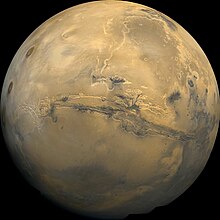
By discovering many geological forms that are typically formed from large amounts of water, the images from the orbiters caused a revolution in our ideas about water on Mars. Huge river valleys were found in many areas. They showed that floods of water broke through dams, carved deep valleys, eroded grooves into bedrock, and travelled thousands of kilometers. Large areas in the southern hemisphere contained branched stream networks, suggesting that rain once fell. The flanks of some volcanoes are believed to have been exposed to rainfall because they resemble those caused on Hawaiian volcanoes. Many craters look as if the impactor fell into mud. When they were formed, ice in the soil may have melted, turned the ground into mud, then flowed across the surface. Normally, material from an impact goes up, then down. It does not flow across the surface, going around obstacles, as it does on some Martian craters.[11][12][13] Regions, called "Chaotic Terrain," seemed to have quickly lost great volumes of water, causing large channels to be formed. The amount of water involved was estimated to ten thousand times the flow of the Mississippi River.[14] Underground volcanism may have melted frozen ice; the water then flowed away and the ground collapsed to leave chaotic terrain.
-
Streamlined islands show that large floods occurred on Mars.
(Lunae Palus quadrangle) -
Scour patterns were produced by flowing water.Dromore crater is at bottom.)
(Lunae Palus quadrangle -
Large floods of water likely eroded the channels aroundDromore crater.)
(Lunae Palus quadrangle -
Arandas crater may be on top of large quantities of water ice, which melted when the impact occurred, producing a mud-like ejecta.
(Mare Acidalium quadrangle) -
Branched channels in Thaumasia quadrangle provide possible evidence of past rain on Mars.
-
These branched channels provide possible evidence of past rain on Mars. (Margaritifer Sinus quadrangle)
Viking landers
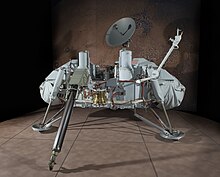

Each lander comprised a six-sided aluminium base with alternate 1.09 and 0.56 m (43 and 22 in) long sides, supported on three extended legs attached to the shorter sides. The leg footpads formed the vertices of an equilateral triangle with 2.21 m (7.3 ft) sides when viewed from above, with the long sides of the base forming a straight line with the two adjoining footpads. Instrumentation was attached inside and on top of the base, elevated above the surface by the extended legs.[15]
Each lander was enclosed in an aeroshell heat shield designed to slow the lander down during the entry phase. To prevent contamination of Mars by Earth organisms, each lander, upon assembly and enclosure within the aeroshell, was enclosed in a pressurized "bioshield" and then sterilized at a temperature of 111 °C (232 °F) for 40 hours. For thermal reasons, the cap of the bioshield was jettisoned after the Centaur upper stage powered the Viking orbiter/lander combination out of Earth orbit.[16]
Astronomer Carl Sagan helped to choose landing sites for both Viking probes.[17]
Entry, Descent and Landing (EDL)
Each lander arrived at Mars attached to the orbiter. The assembly orbited Mars many times before the lander was released and separated from the orbiter for descent to the surface. Descent comprised four distinct phases, starting with a
At landing (after using rocket propellant) the landers had a mass of about 600 kg.
Propulsion
Propulsion for deorbit was provided by the
Terminal
Power
Power was provided by two
Payload
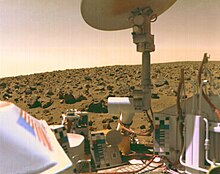
Communications
Communications were accomplished through a 20-watt S-band transmitter using two
Instruments
The lander carried instruments to achieve the primary scientific objectives of the lander mission: to study the
Biological experiments
The Viking landers conducted
Although there was a pronouncement by NASA during the mission saying that the Viking lander results did not demonstrate conclusive
The question of microbial life on Mars remains unresolved. Nonetheless, on April 12, 2012, an international team of scientists reported studies, based on mathematical speculation through
Camera/imaging system
The leader of the imaging team was Thomas A. Mutch, a geologist at Brown University in Providence, Rhode Island. The camera uses a movable mirror to illuminate 12 photodiodes. Each of the 12 silicon diodes are designed to be sensitive to different frequencies of light.
Several broad band diodes (designated BB1, BB2, BB3, and BB4) are placed to focus accurately at distances between six and 43 feet away from the lander.[28] A low resolution broad band diode was named SURVEY.[28] There are also three narrow band low resolution diodes (named BLUE, GREEN and RED) for obtaining color images, and another three (IR1, IR2, and IR3) for infrared imagery.[28]
The cameras scanned at a rate of five vertical scan lines per second, each composed of 512 pixels. The 300 degree panorama images were composed of 9150 lines. The cameras' scan was slow enough that in a crew shot taken during development of the imaging system several members show up several times in the shot as they moved themselves as the camera scanned.[29][30]
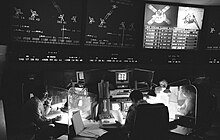
Control systems
The Viking landers used a Guidance, Control and Sequencing Computer (GCSC) consisting of two
Financial cost of the Viking program
The two orbiters cost US$217 million at the time, which is about $1 billion in 2023 dollars.[34][35] The most expensive single part of the program was the lander's life-detection unit, which cost about $60 million then or $400 million in 2023 dollars.[34][35] Development of the Viking lander design cost $357 million.[34] This was decades before NASA's "faster, better, cheaper" approach, and Viking needed to pioneer unprecedented technologies under national pressure brought on by the Cold War and the aftermath of the Space Race, all under the prospect of possibly discovering extraterrestrial life for the first time.[34] The experiments had to adhere to a special 1971 directive that mandated that no single failure shall stop the return of more than one experiment—a difficult and expensive task for a device with over 40,000 parts.[34]
The Viking camera system cost $27.3 million to develop, or about $200 million in 2023 dollars.[34][35] When the Imaging system design was completed, it was difficult to find anyone who could manufacture its advanced design.[34] The program managers were later praised for fending off pressure to go with a simpler, less advanced imaging system, especially when the views rolled in.[34] The program did however save some money by cutting out a third lander and reducing the number of experiments on the lander.[34]
Overall NASA says that $1 billion in 1970s dollars was spent on the program,[5][6] which when inflation-adjusted to 2023 dollars is about $6 billion.[35]
Mission end
The craft all eventually failed, one by one, as follows:[1]
| Craft | Arrival date | Shut-off date | Operational lifetime | Cause of failure |
|---|---|---|---|---|
| Viking 2 orbiter | August 7, 1976 | July 25, 1978 | 1 year, 11 months, 18 days | Shut down after fuel leak in propulsion system. |
| Viking 2 lander | September 3, 1976 | April 11, 1980 | 3 years, 7 months, 8 days | Shut down after battery failure. |
| Viking 1 orbiter | June 19, 1976 | August 17, 1980 | 4 years, 1-month, 19 days | Shut down after depletion of attitude control fuel. |
| Viking 1 lander | July 20, 1976 | November 13, 1982 | 6 years, 3 months, 22 days | Shut down after human error during software update caused the lander's antenna to go down, terminating power and communication. |
The Viking program ended on May 21, 1983. To prevent an imminent impact with Mars the orbit of Viking 1 orbiter was raised on August 7, 1980, before it was shut down 10 days later. Impact and potential contamination on the planet's surface is possible from 2019 onwards.[5]
The Viking 1 lander was found to be about 6 kilometers from its planned landing site by the Mars Reconnaissance Orbiter in December 2006.[36]
Message artifact
Each Viking lander carried a tiny dot of microfilm containing the names of several thousand people who had worked on the mission.[37] Several earlier space probes had carried message artifacts, such as the Pioneer plaque and the Voyager Golden Record. Later probes also carried memorials or lists of names, such as the Perseverance rover which recognizes the almost 11 million people who signed up to include their names on the mission.
Viking lander locations

Legend: Active (white lined, ※) • Inactive • Planned (dash lined, ⁂) )
See also
- Exploration of Mars – Overview of the exploration of Mars
- Life on Mars – Scientific assessments on the microbial habitability of Mars
- List of missions to Mars
- Mars Science Laboratory – Robotic mission that deployed the Curiosity rover to Mars in 2012
- Mars Pathfinder – Mission including first robotic rover to operate on Mars (1997)
- Norman L. Crabill
References
- ^ a b c d e f g h i j Williams, David R. Dr. (December 18, 2006). "Viking Mission to Mars". NASA. Archived from the original on December 6, 2023. Retrieved February 2, 2014.
- JPL. Archivedfrom the original on October 24, 2023. Retrieved February 2, 2014.
- JPL. Archivedfrom the original on October 8, 2023. Retrieved February 2, 2014.
- ^ Soffen, G. A. (July–August 1978). "Mars and the Remarkable Viking Results." Journal of Spacecraft and Rockets. 15 (4): 193-200.
- ^ a b c "Viking 1 Orbiter spacecraft details". NASA Space Science Data Coordinated Archive. NASA. March 20, 2019. Retrieved July 10, 2019.
- ^ a b Howell, Elizabeth (October 26, 2012). "Viking 1: First U.S. Lander on Mars". Space.com. Archived from the original on September 6, 2023. Retrieved December 13, 2016.
- Gross Domestic Product deflatorfigures follow the MeasuringWorth series.
- ^ "The Viking Program". The Center for Planetary Science. Archived from the original on November 20, 2023. Retrieved April 13, 2018.
- ^ "Viking Lander". California Science Center. July 3, 2014. Archived from the original on May 27, 2023. Retrieved April 13, 2018.
- ^ "Viking Fact Sheet" (PDF). Jet Propulsion Laboratory. Archived from the original (PDF) on March 10, 2012. Retrieved March 27, 2012.
- LCCN 92010951. Retrieved March 7, 2011.
- LCCN 98013991.
- ISBN 0-86134-125-2.
- ISBN 0-312-24551-3.
- ^ Hearst Magazines (June 1976). "Amazing Search for Life On Mars". Popular Mechanics. Hearst Magazines. pp. 61–63.
- from the original on February 11, 2023. Retrieved December 21, 2023.
- ^ Kragh, Helge. "Carl Sagan". Encyclopædia Britannica. Archived from the original on November 8, 2023. Retrieved August 9, 2022.
- ^ "Viking". astro.if.ufrgs.br. Archived from the original on August 13, 2023.
- ^ "SNAP-19 Radioisotope Thermoelectric Generator Fact Sheet by Energy Research & Development Administration (ERDA) Diagram 2 - The Energy Research and Development Administration". Google Arts & Culture. Retrieved August 9, 2022.
- PMID 17723090.
- ^ Johnson, John (August 6, 2008). "Perchlorate found in Martian soil". Los Angeles Times. Archived from the original on April 19, 2023.
- ^ "Martian Life Or Not? NASA's Phoenix Team Analyzes Results". Science Daily. August 6, 2008. Archived from the original on November 18, 2023.
- ^ Navarro–Gonzáles, Rafael; Edgar Vargas; José de la Rosa; Alejandro C. Raga; Christopher P. McKay (December 15, 2010). "Reanalysis of the Viking results suggests perchlorate and organics at midlatitudes on Mars". Journal of Geophysical Research: Planets. Vol. 115, no. E12010. Archived from the original on January 9, 2011. Retrieved January 7, 2011.
- ^ Than, Ker (April 15, 2012). "Life on Mars Found by NASA's Viking Mission". National Geographic. Archived from the original on April 15, 2012. Retrieved April 13, 2018.
- .
- ^ Klotz, Irene (April 12, 2012). "Mars Viking Robots 'Found Life'". DiscoveryNews. Retrieved April 16, 2012.
- (PDF) from the original on November 3, 2020.
- ^ a b c "PDS: Instrument Information". pds.nasa.gov. Retrieved March 28, 2023.
- ^ The Viking Lander Imaging Team (1978). "Chapter 8: Cameras Without Pictures". The Martian Landscape. NASA. p. 22.
- ^ McElheny, Victor K. (July 21, 1976). "Viking Cameras Light in Weight, Use Little Power, Work Slowly". The New York Times. Archived from the original on February 22, 2021. Retrieved September 28, 2013.
- ^ Tomayko, James (March 1988). Computers in Spaceflight: The NASA Experience (Technical report). NASA. CR-182505. Archived from the original on May 6, 2023. Retrieved February 6, 2010.
- ^ Holmberg, Neil A.; Robert P. Faust; H. Milton Holt (November 1980). "NASA Reference Publication 1027: Viking '75 spacecraft design and test summary. Volume 1 – Lander design" (PDF). NASA. Retrieved February 6, 2010.
- ^ Holmberg, Neil A.; Robert P. Faust; H. Milton Holt (November 1980). "NASA Reference Publication 1027: Viking '75 spacecraft design and test summary. Volume 2 – Orbiter design" (PDF). NASA. Retrieved February 6, 2010.
- ^ ISBN 978-0-8018-6720-0.
- ^ Nominal Gross Domestic Productper capita is used for the inflation-adjusting calculation.
- ^ Chandler, David (December 5, 2006). "Probe's powerful camera spots Vikings on Mars". New Scientist. Retrieved October 8, 2013.
- ^ "Visions of Mars: Then and Now". The Planetary Society.
Further reading
- On Mars: Exploration of the Red Planet Archived February 5, 2007, at the Wayback Machine
- Viking Orbiter Views of Mars
- The Martian Landscape SP-425
- Analytical Chemistry feature article about the Viking spacecraft's scientific mission
- Viking '75 spacecraft design and test summary. Volume 1 Lander design – NASA Report Archived October 27, 2020, at the Wayback Machine
- Viking '75 spacecraft design and test summary. Volume 2 Orbiter design – NASA Report Archived October 27, 2020, at the Wayback Machine
- Viking '75 spacecraft design and test summary. Volume 3 Engineering test summary – NASA Report Archived October 28, 2020, at the Wayback Machine
External links
- NASA Mars Viking Mission
- Viking Mission to Mars (NASA SP-334) Archived August 7, 2013, at the Wayback Machine
- Solar Views Project Viking Fact Sheet
- Viking Mission to Mars Archived July 16, 2011, at the Wayback Machine Video
- A diagram of the Viking and its flight profile
- Article at Smithsonian Air and Space Website
- The Viking Mars Missions Education & Preservation Project (VMMEPP)
- VMMEPP Online exhibit
- 45 years ago: Viking 1 Touches Down on Mars


